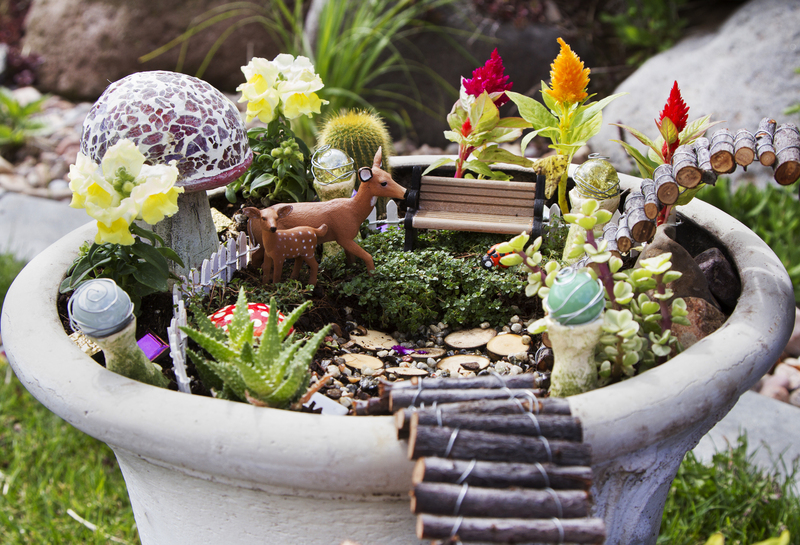Secrets to a Thriving Lawn Even During the Summer Drought Season
Summertime can be brutal on your beautiful green lawn, especially when rain is scarce and temperatures soar. If you're struggling to keep your grass lush, healthy, and vibrant, you're not alone. Fortunately, with the right approach and expert care, your yard can flourish even during the most intense summer droughts. In this comprehensive guide, we'll explore proven strategies and secrets to maintaining a thriving lawn through the drought season. Get ready for a season of healthy, resilient grass!
Understanding Drought Stress and Its Effects on Lawns
Before diving into watering schedules and fertilizer choices, let's begin by understanding why lawns struggle during drought.
What Is Drought Stress?
Drought stress occurs when grass does not get enough water to meet its basic needs. High summer temperatures often exacerbate this condition as evaporation rates climb and soil moisture diminishes. As a result, lawns may:
- Develop yellow or brown patches
- Appear wilted or thin
- Stop growing or go dormant
- Become more susceptible to pests and weeds
Why Are Summer Lawns Hardest Hit?
Summer drought is a double threat for lawns because not only are rainfall levels lower, but daytime temperatures are also higher. Many cool-season grasses enter a state of dormancy to survive, while warm-season varieties may still struggle if deprived of water. Understanding your lawn's grass type is key to implementing the best drought survival tactics.

Choosing the Best Grass for Drought-Tolerant Lawns
The journey to a thriving lawn during a summer drought season often begins with selecting the right type of grass. Some grass varieties are much more tolerant of dry, hot conditions than others.
Top Drought-Resistant Grass Types
- Bermuda Grass: Excellent heat and drought tolerance; ideal for full sun areas.
- Zoysia Grass: Dense growth resists drought and disease, with moderate water needs.
- Buffalo Grass: Native to prairies; thrives in drought and requires little water.
- Fescue (Tall and Fine): Performs well in shade and with limited water.
- Bahia Grass: Adapted to sandy, infertile soils and tolerates drought well.
By starting with the right variety, you're giving your lawn a built-in advantage during harsh, dry summers.
Secrets to Watering Lawns During Drought
Efficient watering is the most critical factor in keeping your grass alive during drought periods. Here's how to make every drop count.
Water Deeply, Not Frequently
An essential tip for keeping lawns green during a drought is to water deeply but infrequently. Shallow watering encourages shallow root growth, which makes your grass more vulnerable to drought stress. Instead:
- Water only 1-2 times per week, providing 1 inch of water each time
- Allow soil to partially dry out between waterings to stimulate deep root growth
- Test soil moisture with a screwdriver; if it passes easily through the top 4-6 inches, your lawn is well-watered
Water Early in the Morning
Early morning watering, preferably before 9 a.m., is ideal because the temperature is cooler, so less water is lost to evaporation. Avoid watering during midday or in the evening to prevent fungus growth and maximize water use efficiency.
Use the Right Irrigation Methods
- Sprinkler systems: Adjust timers during drought to reduce run-times and prevent overwatering.
- Soaker hoses or drip irrigation: Deliver water directly to the soil, reducing waste from evaporation.
Also, check for leaks or clogged emitters to make the most of scarce water resources.
Smart Mowing Practices for Drought-Season Lawns
Mowing isn't just about appearances; smart mowing habits play a significant role in protecting your lawn from summer drought stress.
Keep Your Grass Longer
During droughts, set your mower blades higher. Allowing your grass to grow a little longer (around 3-4 inches for most varieties) helps:
- Shade the soil, reducing evaporation
- Encourage deeper roots
- Decrease weed growth
Sharpen Your Mower Blades
Dull mower blades tear grass blades, which increases water loss and stresses your turf. Always mow with sharp blades to keep cuts clean and minimize lawn injury during drought.
Avoid Cutting Wet Grass
Mowing wet grass is never recommended, especially during droughts, because it can damage the blades and the underlying soil structure. Wait until the grass is dry to avoid clumping and uneven cuts.
Mulching: Your Lawn's Built-In Drought Defense
Mulching offers multiple benefits for lawns under drought stress. Spreading a thin, even layer of mulch or allowing grass clippings to remain after mowing:
- Locks in soil moisture
- Insulates roots from extreme temperatures
- Adds nutrients as clippings break down
Grasscycling - leaving clippings on the lawn rather than bagging them - is a simple, eco-friendly practice that can reduce water needs during the summer.
Lawn Fertilization During Drought: What to Know
While it's tempting to boost your lawn's growth with fertilizer, doing so during the summer drought season can actually stress your grass further.
Do Not Over-Fertilize
Fertilizing during extreme heat requires caution. Over-fertilization can:
- Burn grass blades
- Encourage tender, weak growth
- Increase water requirements
If you must fertilize, opt for slow-release, organic products, and use lower rates than usual. Ideally, fertilize in the spring or fall before the drought arrives.
Focus on Soil Health
Healthy soil is the secret to drought-tolerant lawns. Regularly amend soil with compost, biochar, or organic matter to improve water retention and provide a buffer against hot, dry spells.
Weed Control: Why It Matters More in the Drought Season
Weeds compete with your grass for precious water during droughts. Staying vigilant with weed control is crucial:
- Hand-pull weeds as soon as you see them
- Spot-treat with safe herbicides only when necessary
- Maintain healthy, dense turf to prevent weed invasion
Tip: Avoid applying harsh chemicals during extreme heat, as both weeds and your desirable grass may suffer.
Repairing and Reviving a Damaged Lawn Post-Drought
If your lawn has succumbed to drought stress, don't despair. Lawn recovery is possible with the right steps once more favorable weather returns.
Steps to Lawn Renewal
- Rake away dead grass and debris to make way for new growth
- Overseed bare patches with a drought-tolerant grass variety
- Topdress with compost to enhance moisture retention and nutrient content
- Water consistently as the lawn recovers, but don't saturate
- Fertilize lightly with slow-release nutrients in fall
Eco-Friendly and Advanced Solutions for Summer Drought Lawns
Embrace innovation and sustainability to keep your lawn thriving even during extended dry spells:
Install Smart Irrigation Systems
Smart irrigation systems offer significant advantages over traditional timers. These devices adjust watering automatically, based on current weather and soil moisture levels, to reduce waste and conserve water during a drought.
Xeriscaping: Sustainable Landscaping
Xeriscaping is the practice of designing landscapes to minimize water use. Consider incorporating drought-resistant grasses, native plants, and mulched ornamental areas. Not only does this approach conserve water, but it also creates beautiful, low-maintenance yards.
Catch and Save Rainwater
Install rain barrels or cisterns to capture rainfall from your roof. Use it for supplemental watering during dry spells. This not only lowers your water bill but also ensures your lawn receives high-quality, chlorine-free water.
Soil Wetting Agents
Soil wetting agents help water penetrate compacted or hydrophobic soils. This technique ensures that the water you apply reaches the root zone where it is needed most.
Common Mistakes to Avoid for Drought-Season Lawns
Even the best intentions won't help if you're practicing lawn care myths. Here's what to avoid:
- Overwatering: Causes disease and makes lawns water-dependent
- Scalping the lawn: Leaves soil exposed and increases evaporation
- Applying quick-release fertilizer: Burns turf and stresses roots
- Mowing during heatwaves: Causes excessive stress
- Ignoring weeds: Weeds steal limited water from your grass
Frequently Asked Questions About Thriving Lawns in Drought
Can I skip watering when my lawn goes dormant?
Yes, within reason: Healthy lawns can survive four to six weeks in dormancy. Water with about 1/2 inch every two weeks during extended droughts to help roots survive until rain returns.
Should I stop mowing entirely in summer drought?
No, but mow less frequently, and keep blades higher. Mow only when the grass is actually growing and the soil isn't too dry.
My lawn's turning brown - is it dead or just dormant?
Browning is usually a sign of dormancy, especially for cool-season grasses. Test by tugging gently on the grass blades; if they resist and don't pull up easily, the grass is alive.

Your Summer Drought Lawn Survival Checklist
- Test your soil for compaction and nutrient levels before summer begins
- Choose drought-resistant grass varieties for new plantings or overseeding
- Water deeply and early, making use of smart or efficient irrigation systems
- Keep mower blades high and sharp for strong, shade-casting blades
- Mulch and grasscycle to retain moisture, never bagging clippings during drought
- Weed regularly to reduce competition for water
- Use fertilizers sparingly and choose slow-release or organic options
- Plan for recovery with gentle after-drought care such as overseeding and compost topdressing
Conclusion: Achieving a Lush Lawn Even in Summer Drought
Maintaining a vibrant, healthy lawn during the toughest summer drought season requires a combination of smart watering, proper mowing, soil care, and plant selection. By understanding the needs of your turf and implementing these lawn care secrets and drought-busting strategies, you can enjoy a resilient, green lawn all summer long--no matter how hot and dry it gets.
Remember, the best defense is preparation. Enhance your soil health, manage water wisely, and adapt your maintenance routines according to the needs of your turf. With these expert-backed tips, you can say goodbye to brown patches and hello to a lush, thriving landscape--even in the most challenging weather.
Ready for your best summer lawn ever? Start applying these proven secrets today, and watch your yard weather any drought season in style.